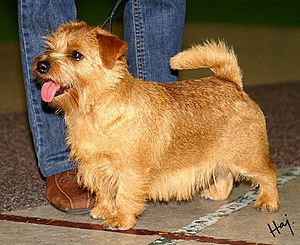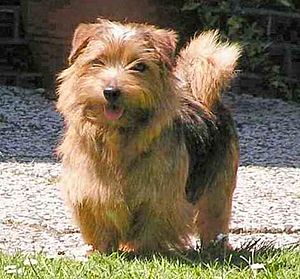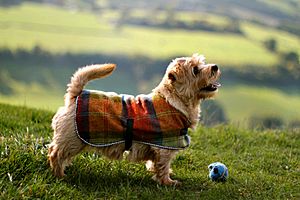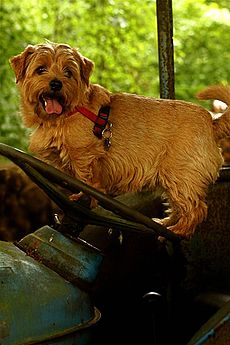Norfolk Terrier facts for kids

A tan-coloured Norfolk Terrier
|
||||||||
| Origin | Great Britain | |||||||
|---|---|---|---|---|---|---|---|---|
|
||||||||
| Domestic dog (Canis lupus familiaris) | ||||||||
The Norfolk Terrier is a small, friendly dog breed from Great Britain. Before 1964, it was seen as a type of Norwich Terrier. The main difference was its "drop ears" (folded ears), while the Norwich Terrier has "prick ears" (pointy ears). Both the Norfolk and Norwich Terriers are the smallest of the working terriers.
Contents
About the Norfolk Terrier
What They Look Like
The Norfolk Terrier has a rough, wiry coat. It can be many shades of red, wheaten (light yellow-brown), black and tan, or grizzle (a mix of black and white hairs).
They are the smallest of the working terriers. These dogs are active and strong. They move freely and have good bone structure. "Good substance" means they have a strong body and bones that fit well. This helps them be very quick and agile. They were often used to catch rats or other small animals.
Norfolk Terriers have balanced bodies. A dog that is too heavy would not be quick. A dog that is too thin might be seen as a toy breed. Norfolks usually have a longer stride and stronger back legs. This helps them cover more ground than their Norwich cousins. They also have a good side gait (how they walk from the side). This is because their front and back legs are well-balanced. Their back is also a bit longer.
An ideal Norfolk Terrier is about 9 to 10 in (23 to 25 cm) tall at the shoulders. They usually weigh about 11 to 12 lb (5.0 to 5.4 kg).
Their Personality
Norfolk Terriers are known for being brave. However, they can also be a bit stubborn sometimes. Along with Norwich Terriers and Border Terriers, they are considered to have the calmest personalities among the Terrier group. Norfolks often work in groups, so they usually get along well with other dogs.
As pets, they love people and children. They make good family companions. Their energy level often matches the home they live in. These dogs should live inside with their families. They really enjoy being around people.
Generally, Norfolks do not dig a lot. But like any dog, they might dig if they get bored and are left alone too long. Norfolks are not usually loud barkers. They will bark when needed, though, as they make good watchdogs. They usually live well with other pets in the house if they meet them as puppies. Outside, they are natural hunters. They have a strong desire to chase small animals.
How They Used to Work
Norfolk Terriers were first bred to be farm dogs. Their job was to get rid of small animals like rats in barns. Some old writings suggest they were also used for hunting. They would help chase out animals of similar size from their dens.
Today, some Norfolks are still used for this purpose in parts of Europe. Norfolks are pack animals. This means they are expected to get along with other dogs while working or at home. As a pack dog, they would take turns chasing their prey. They are very brave and fearless. Now, most Norfolks are family pets. So, they must have a friendly nature for living with people.
Norfolk Terrier Health
Norfolk Terriers usually live for 8 to 14 years. Some have even lived as long as 17 years. Norfolks can sometimes have certain health issues. These include heart problems like mitral valve disease. They can also have luxating patellas, which means their kneecaps can slip out of place. Sometimes their teeth do not line up correctly. This is called an "incorrect bite."
Many Norfolks have shallow hip sockets. This can lead to a condition called hip dysplasia. This means the hip joint does not form correctly. Responsible breeders test their dogs for hip dysplasia. They use special X-rays to check their hips. This helps them make sure they are breeding healthy dogs.
Norfolks usually have small to medium-sized litters of puppies. Good breeders only breed healthy dogs. These dogs should have a good personality and come from healthy family lines. They should also look like the breed standard. Many people want Norfolk Terriers, so there are often more people wanting puppies than there are puppies available. How a puppy is raised affects its personality for its whole life.
Caring for a Norfolk Terrier
Grooming Their Coat
Norfolk Terriers have a double coat. This means they have two layers of fur. The topcoat is rough and wiry. The undercoat is soft and warm. It is best to comb their coat daily with a steel comb. But for a pet dog, combing once a week is usually enough. This helps remove loose, dead hairs and stops the coat from getting tangled.
At least twice a year, in the spring and fall, their coat should be "hand stripped." This means pulling out the old, dead hairs by hand. Clipping or cutting their coat can ruin its natural colors and rough texture. You can wash a Norfolk Terrier with dog shampoo when it gets dirty. This breed is considered mostly hypoallergenic. This means they are less likely to cause allergies. However, they do shed a little bit all year round.
History of the Breed
In the 1880s, people in Great Britain developed a working terrier. This happened in East Anglia, a region in eastern England. The Norwich Terrier and later the Norfolk Terrier (with drop ears) came from this area. It is believed they were created by mixing local terrier-like dogs. They also used small, short-legged Irish Terrier breeds. Another influence was the small red terriers used by the Romani ratters in Norfolk.
These dogs were first called the Cantab Terrier. This was because students at Cambridge University in England liked to keep them. Later, they were called the Trumpington Terrier. This name came from Trumpington Street, where the breed was further developed. Just before World War I, an Irish horse rider named Frank Jones sold many of these short-legged terriers to the United States. So, in America, they were called Jones Terriers. It was Jones who said these terriers came from Norwich.
In 1932, the Norwich Terrier was accepted by the English Kennel Club. The first written description of the breed was made then. The American Kennel Club registered its first Norwich Terrier in 1936. In 1964, The Kennel Club decided to make the drop-eared variety its own breed. They named it the Norfolk Terrier. The prick-eared variety kept the name Norwich Terrier. The American Kennel Club and Canadian Kennel Club also recognized this split in 1979. The United Kennel Club recognized the Norfolk Terrier in 1979. Over many years, these two breeds have become quite different. They now have distinct looks and personalities. Some people even believe that the Norfolk and Norwich were always separate breeds. They think it was a mistake to classify them as one in the first place.
See also
 In Spanish: Terrier de Norfolk para niños
In Spanish: Terrier de Norfolk para niños






